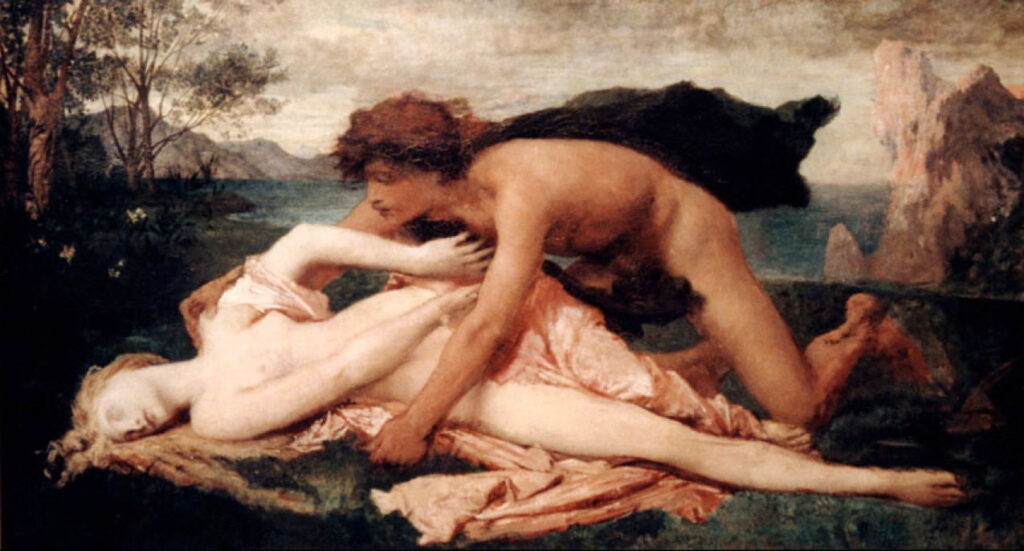Changing Paintings: 56 The hawk, kingfishers and a diver

With Peleus and Thetis safely married and the birth of their son Achilles, Ovid brings Book Eleven of his Metamorphoses to a close with a series of less-known myths that have also been rarely depicted.
Peleus, with his sheep and cattle, was forced to flee from Aegina to Trachis after he had been involved with his brother Telamon in the killing of their brother Phocus. When in Trachis, Peleus kept company with King Ceyx, son of Lucifer (the Morning Star, not the devil). The king told the story of his brother Daedalion, whose daughter Chione was raped on the same night by both Mercury and Apollo. She conceived by them, and gave birth to twins, Autolycus and Philammon. However, Chione was very beautiful, and boasted that she was fairer than the goddess Diana.
Diana decided to silence her, so shot an arrow through Chione’s tongue, causing her not only to fall dumb, but to bleed to death. Her father Daedalion tried to throw himself on Chione’s funeral pyre four times. Eventually, in his grief, he ran off and threw himself from the top of Mount Parnassus, and was turned into a hawk by Apollo.
Johann Wilhelm Baur (1600-1640), Chione (c 1639), engraving for Ovid’s Metamorphoses, further details not known. Wikimedia Commons.
Johann Wilhelm Baur’s set of engravings to illustrate Ovid’s Metamorphoses include a particularly fine account of Chione (c 1639), with rich multiplex narrative. At the left, in the foreground, the vengeful Diana has just loosed an arrow, still in flight, at Chione on the right. She is shown with her twins Autolycus and Philammon. Behind them, in the centre, Daedalion tries to throw himself on Chione’s funeral pyre, then hurls himself from the sea cliff, being transformed into a hawk.
As Ceyx was telling of Daedalion being turned into a hawk, the royal herdsman rushed in and reported that a monster wolf was killing their cattle down by the beach. Ceyx had his men prepare to go and tackle the beast, but Peleus offered to deal with this by praying to the sea-goddess who was responsible. They went down to a lighthouse tower above the beach, and saw the bodies of many mutilated cattle and the wolf covered in their blood. Peleus prayed to Psamathe, and his wife Thetis secured the solution as that goddess turned the monster wolf into marble.
Ovid’s penultimate story in this book concerns King Ceyx and his wife Halcyone (or Alcyone), and is told at length, with several lyrical passages, particularly those describing the storm and shipwreck.
Ceyx was still troubled by his brother’s transformation into a hawk, and wanted to visit an oracle. However, the road to that at Delphi was blocked by bandits, so he was forced to go by sea to the oracle at Claros in Ionia. That troubled his wife, but Ceyx pointed out that his father Aeolus ruled the winds so should ensure his safe passage.
Ceyx set out, Halcyone sobbing as he left. At first the ship’s crew had to row because of the lack of wind, but soon there was enough to stow the oars and proceed under sail. By nightfall the wind was blowing a gale, and the sails were fully reefed as they tried to weather the storm out. The waves grew larger until they came crashing down on their ship.
With water pouring in, the tenth wave (by legend always the largest) broke the vessel up, it sank, and its terrified crew drowned. Ceyx, his thoughts turning to his wife, clung to wreckage, fighting for his life. Just before he too drowned, he prayed for the waves to carry his body to the shore, so his wife could tend to it before burial. Still muttering her name, he sank into the black water and died.
Knowing nothing of this, Halcyone prepared for Ceyx’s return, and worshipped at Juno’s shrine. The goddess took pity on her, and despatched Iris to wake Sleep and break the news of Ceyx’s death to his wife. Sleep did this through his son Morpheus, who appeared to Halcyone in her sleep as the ghost of her dead husband. Halcyone woke as Morpheus went away, realised that he was only a ghost, and descended into profound grief. In the morning, she went to the shore to look for her husband’s body, which she saw slowly washing in on the tide. Ceyx and Halcyone were then transformed into kingfishers.
Herbert James Draper (1863–1920), Halcyone (1915), oil on canvas, 61 x 85 cm, Private collection. Wikimedia Commons.
Herbert James Draper’s oil painting of Halcyone from 1915 shows the widow looking out to sea, watching Ceyx’s body float slowly in. He completes the story with a pair of kingfishers flying above her head, matching the kingfisher blue of her clothes.
Helen Isobel Mansfield Ramsey Stratton (1867-1961), Ceyx and Halcyone (c 1915), illustration in ‘A Book of Myths’, by Jean Lang, 1915, Jack, London. Wikimedia Commons.
Helen Stratton’s illustration of Ceyx and Halcyone, published in 1915, doesn’t follow Ovid’s account as closely. The sea is still rough, and spume covers the beach. Halcyone is walking past flotsam from the wreck, but the birds appear to be terns and are definitely not kingfishers, however inappropriate they might be on a beach.
A man watching kingfishers fly together tells the final story of Book Eleven, of one of the sons of Priam king of Troy, thus Hector’s brother. While Hector’s mother was Hecuba, this brother, Aesacus, was secretly born of Alexiroe. Unlike his more famous brother, Aesacus shunned Troy and populous places. He often pursued Hesperia, daughter of the river-god Cebren, but one day as she was fleeing from him, she was bitten on her foot by a venomous snake. She died immediately, and Aesacus held her limp body in his arms, blaming himself for being the cause of her death. He went straight to the top of a sea cliff and flung himself from it. Tethys took care of him as he entered the water, and transformed him into a diver (a seabird).
Virgil Solis (1514–1562), Aesacus and Hesperia (date not known), engraving in Ovid’s Metamorphoses, further details not known. Wikimedia Commons.
Although seldom painted, this myth does have the benefit of a fine engraving by Virgil Solis of Aesacus and Hesperia for sixteenth century editions of Ovid’s Metamorphoses. In the foreground, Aesacus has just caught up with the dead body of Hesperia, the offending snake still by her foot. Behind them is the sight of Aesacus throwing himself from the top of a cliff, with Tethys ready to catch him below.
Jules-Élie Delaunay (1828-1891), The Death of the Nymph Hesperia (1859), oil, dimensions not known, Ny Carlsberg Glyptotek, Copenhagen, Denmark. Wikimedia Commons.
The great nineteenth century narrative painter Jules-Élie Delaunay, a friend of Gustave Moreau, is probably the only painter to have depicted this story in a significant work, The Death of the Nymph Hesperia (1859). I apologise for the poor image quality, which lacks sufficient detail to determine whether the snake is still present. Hesperia lies, cold, white and dead, as Aesacus blames himself for the tragedy. At the top right corner are the overhanging cliffs from which Aesacus will shortly hurl himself.
This brings us to the end of Book Eleven.

